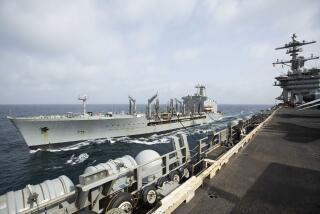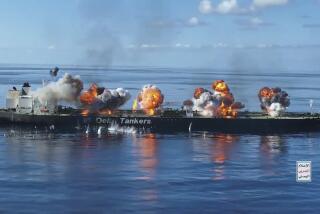Soviet Sub Sinks, Taking 16 A-Missiles to Bottom of Sea : No Danger of Leak or Blast: U.S.
- Share via
WASHINGTON — A crippled Soviet nuclear-powered submarine that was racked by an enormous explosion Friday sank today in 18,000 feet of water in the Atlantic Ocean, taking its 16 nuclear-tipped missiles and nuclear power plant to the bottom, Pentagon officials said.
Lifeboats that removed a skeleton crew were seen in the water 30 minutes before the sub sank, officials said. Three crewmen were killed in the original explosion Friday, Soviet authorities said.
Preliminary air and water samplings taken by U.S. Navy P-3 Orion aircraft indicated that there was no leakage of radiation from the submarine, either from its nuclear reactor or the 16 liquid-fueled SSN-6 missiles aboard. Each of the missiles carries two warheads, officials of the Joint Chiefs of Staff said.
Officials at a Pentagon briefing displayed color pictures of the crippled sub, taken Saturday by a U.S. patrol plane, that showed smoke rising from a jagged hole in the deck and part of the heavy metal decking peeled back.
‘Force . . . Enormous’
Vice Adm. Powell Carter said the “force of the explosion was enormous.”
But he said that the fuel for the nuclear reactors aboard the sub is encased in heavy metal that will deteriorate very slowly and that the nuclear missiles will be disabled by the great pressure of the sea’s depth.
Pentagon sources said the Soviet Union is not believed to have any vessel capable of raising the submarine or pieces of the sub from such a depth. But Carter said the Soviets do have a submersible capable of diving to such depths to study the wreck.
The United States has the now-mothballed Glomar Explorer, which has attempted such deep recoveries in the past. The ship was used in 1974 to recover pieces of another Soviet submarine that sank in the Pacific not far from Hawaii.
No Danger of Blast or Leak
Carter indicated that Friday’s fire may have started within the liquid-fueled missile.
“These liquid-fueled systems are extremely dangerous,” the admiral said. “That’s why we moved to solid-fuel systems early on” aboard U.S. submarines.
Asked whether there is danger of an explosion or a leak of radioactivity, Carter replied, “None.
The Soviet Union, which first notified the United States of the crippled sub Saturday, also said there had been no radiation leakage. Pentagon officials said an oceangoing tug, the Powhatan, as well as the Navy sub-hunting planes, is in the vicinity of the sinking and has not detected leakage.
The 1960s vintage Yankee I class missile sub sank 1,060 nautical miles east of Cape Hatteras, N.C., and 80 miles from where it first rose to the surface Friday, the Pentagon said. Crewmen remaining aboard abandoned ship in life rafts 30 minutes before the sinking, the officials said.
‘Uncontrolled Flooding’
“A likely cause of the sinking was uncontrolled flooding from damage to the pressure hull or damage to seawater systems from the fire and probable explosion,” Pentagon spokesman Fred Hoffman told a news conference.
Lt. Gen. Richard Burpee said the United States confirmed that the sub was lost when it disappeared from radar screens and was seen going down in the light of green and red flares fired by accompanying Soviet ships. The 426-foot-long sub normally has a crew of 120. After the original explosion Friday, all but a skeleton crew were removed when the battered boat was taken under tow.
Pentagon officials ruled out any possibility that the Soviets scuttled the sub.
The sub had been towed only 80 miles at a torturous 2 m.p.h. from the site of the explosion when the end came.
More to Read
Sign up for Essential California
The most important California stories and recommendations in your inbox every morning.
You may occasionally receive promotional content from the Los Angeles Times.










